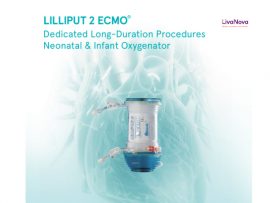Abstract Objectives: An increasing number of pediatric centers use the femoral vein in neonates and smaller children to provide venovenous multisite (VVMS) extracorporeal membrane oxygenation (ECMO), but there are no..
Read MoreAbstract Background Respiratory management of extremely low gestational age neonates (ELGANs) is a major challenge in neonatal intensive care, as they face high mortality and morbidity due to complications such..
Read MoreAbstract Background Mortality in congenital diaphragmatic hernia (CDH) approximates 30 %. Both severe lung hypoplasia and other anomalies contribute to demise regardless of repair and/or extracorporeal membrane oxygenation (ECMO). We..
Read MoreAbstract Objective To summarize the management experience of inter-hospital transport of critically ill children with extracorporeal membrane oxygenation (ECMO) in our hospital and provide evidence for the mobile ECMO for..
Read MoreAbstract Background: The use of VA extracorporeal membrane oxygenation (ECMO) for cardiac recovery is widely adopted, with extensive publications on assessing readiness to wean from VA ECMO. Techniques to reduce..
Read MoreAbstract Extreme prematurity carries a high burden of morbidity and mortality. The artificial placenta is an emerging therapy that has the potential to improve outcomes in these patients. However, current..
Read MoreAbstract Introduction Extracorporeal membrane oxygenation (ECMO) is utilized in critically ill neonates with severe cardiopulmonary failure. Hemolysis is a potential complication and is associated with significantly increased morbidity and mortality...
Read MoreAbstract Venovenous extracorporeal membrane oxygenation (VV ECMO) has become an increasingly preferred modality for respiratory support in neonates and infants under 10 kg, driven by a growing recognition of its..
Read MoreAbstract This study analyzed the outcomes of neonates undergoing a second run of extracorporeal membrane oxygenation (ECMO) to determine whether there is a benefit to a repeated run. We used..
Read MoreAbstract Congenital diaphragmatic hernia (CDH) is a rare and severe malformation that can lead to life-threatening postnatal physiological challenges which may require lifesaving extracorporeal membrane oxygenation (ECMO) support, sometimes more..
Read MoreAbstract Background Young patients may survive accidental deep hypothermia with prolonged asystolic circulatory arrest because of protective effects of cold. Case Summary An 8-year-old boy fell through pond ice and..
Read MoreAbstract Objective To describe cardiac arrest during anesthesia care provided by a pediatric cardiac anesthesiologist in patients with congenital heart disease and identify predictors of outcome. Design Retrospective chart review...
Read MoreAbstract Background Amniotic fluid embolism is a rare potential complication in the peripartum period. Case Summary A 27-year-old nulliparous woman presented for elective induction at 41 weeks' gestation. Due to..
Read MoreAbstract Background Congenital heart disease (CHD) that requires heart surgery is common. Severe postoperative pulmonary hypertension (PH) occurs in 2% of cardiac procedures and is associated with high morbidity and..
Read MoreAbstract The correct arterial cannula size for percutaneous femoral venoarterial extracorporeal membrane oxygenation (VA-ECMO) cannulation is imperative for adequate circulatory support. We aimed to describe the relationship between cannula size,..
Read MoreAbstract Objetives Extracorporeal membrane oxygenation (ECMO) after surgery for congenital heart disease (CHD) provides hemodynamic support to patients when their myocardial function is temporarily affected. Postoperative infections in children with..
Read MoreAbstract Infection cases have been reported where Legionella spp. and NTM (non-tuberculous mycobacteria) increased due to the contamination of circulating water in cold/heated water supply systems for extracorporeal circulation used in cardiac..
Read MoreAbstract Introduction Current guidelines advise that anaphylactic shock refractory to traditional treatments may be managed with extracorporeal life support (ECLS), but reports have been exclusive to adults. Case Report We..
Read MoreAbstract Background:Mechanical circulatory support, and specifically extra-corporeal membrane oxygenation, plays a critical role in managing paediatric cardiac patients with severe heart failure. Whilst these technologies are vital for bridging patients..
Read MoreAbstract The use of extracorporeal membrane oxygenation (ECMO) in the paediatric population has increased over time, with the ability to rescue pulmonary and cardiovascular deterioration. ECMO can be utilised by..
Read MoreAbstract Background Venoarterial extracorporeal membrane oxygenation (VA ECMO) is a critical therapeutic intervention that is commonly used in the management of paediatric patients with congenital heart disease (CHD). This procedure..
Read MoreAbstract Extracorporeal membrane oxygenation (ECMO) is a high-risk and low-volume life support with increasing clinical study. However, heterogenous outcome definitions impede data assimilation into evidence to guide practice. The Academic..
Read MoreAbstract Introduction Oxygenators for paediatric Extracorporeal Membrane Oxygenation (ECMO) are required to operate over a wide range of flow rates, in a patient group ranging from neonates through to fully..
Read MoreAbstract Extracorporeal Cardiopulmonary Resuscitation (ECPR) has potential benefits compared to conventional Cardiopulmonary Resuscitation (CCPR) in children. Although no randomised trials for paediatric ECPR have been conducted, there is extensive literature..
Read MoreAbstract Methemoglobinemia is a rare blood disorder that can have severe consequences if not promptly diagnosed and treated. In this article, we will explore a real-life case study of a..
Read MoreAbstract Despite increasing early rehabilitation and mobilisation (ERM) in paediatric intensive care, current evidence for ERM of neonatal and paediatric patients receiving extracorporeal membrane oxygenation (ECMO) is limited. The proposed..
Read MoreAbstract Peripheral veno-artertial extracorporeal membrane oxygenation (VA-ECMO) is commonly used in the paediatric population for intractable respiratory and cardiac failure. One of the devastating complications of VA-ECMO is severe brain..
Read MoreAbstract Background: Postcardiotomy cardiogenic shock (PCS) that is refractory to inotropic support remains a major concern in cardiac surgery and is almost universally fatal unless treated with mechanical support. While reported..
Read MoreAbstract Aims Unfractionated heparin (UFH) has been the primary anticoagulant of choice on extracorporeal membrane oxygenation (ECMO). However, it is debatable whether bivalirudin (BIV), a direct thrombin inhibitor, may be..
Read MoreAbstract Background: Extracorporeal membrane oxygenation (ECMO) is a supportive therapy used in the most severe forms of acute respiratory distress syndrome. Due to its intrinsic complexity and relatively low annual..
Read More













